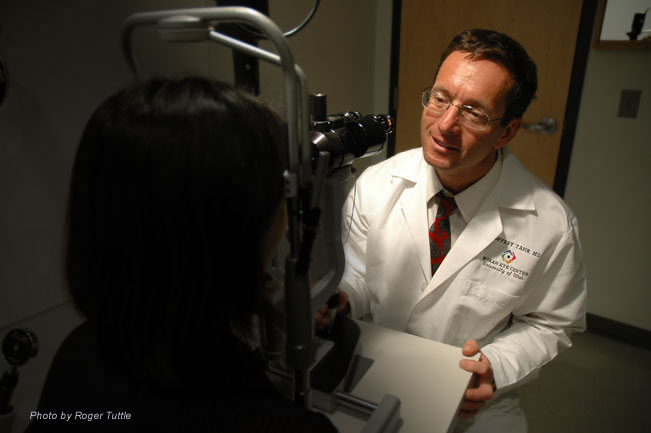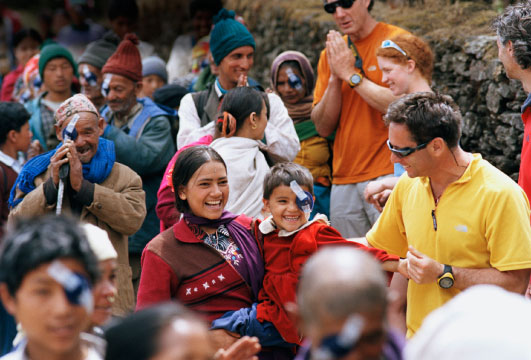
|
|
About Continuum Advertising Advisory Committee Archives Contact Us Continuum Home Faculty/Staff Subscribe related websites Alumni Association Marketing & Communications University of Utah Home |

Spotlight
The VisionaryOphthalmologist Geoffrey Tabin has bagged the world’s highest peaks, but that’s nothing compared to his day job: miracle worker. by Jason Matthew Smith Go ahead, ask U of U ophthalmologist Geoff Tabin about the bungee jump that made him famous. He’ll offer up a wry smirk, then ask, “Where did you hear about that?” Well, anywhere that extreme sport aficionados—the ones who really know the sport—gather, brag, or blog. They’ll tell you that Tabin, now professor of Ophthalmology and Visual Sciences and director of the U’s Division for International Ophthalmology, was the first American to bungee jump, in the early 1980s. If you don’t believe it, there’s proof on film. An early episode of the program “That’s Incredible!” features Tabin leaping off Colorado’s Royal Gorge Bridge toward the Arkansas River 1,100 feet below. In a white tux. Tabin does nothing halfway. He has climbed Everest’s Kangshung Face, and, by 1991, had become only the fourth person in the world to ascend the Seven Summits, the highest points on all seven continents. A graduate of Yale University, Tabin studied philosophy at Oxford and entered Harvard medical school in 1980, but by his own admission, he had little idea of what he wanted to do in medicine. Instead, he was consumed by clawing his way to the roof of the world or plunging off its edges. “It was a big focus of my life for many years,” he says. Then, in March 1990, Tabin had what you might call an epiphany. While in Nepal, after a climb up and down Everest, he witnessed Dutch doctors performing cataract surgery on some of the local population. If the results of certain surgeries can be considered “miracles,” then cataract surgery would top the list. Cataracts, opaque films that can grow to cover the eye, are the leading cause of blindness worldwide, afflicting some 16 million people. A relatively simple, outpatient surgical procedure can completely restore sight by removing the clouded lens and replacing it with an implant. Tabin was enthralled with the possibility of utilizing the procedure to help an enormous number of people. “I saw it as an area where you could make a huge impact,” he says. And it certainly impacted him as well—he returned to the States to train in ophthalmology at Brown University. After a corneal surgery fellowship in Australia, Tabin returned to Nepal and teamed up with Nepalese ophthalmologist Sanduk Ruit, who had pioneered eye surgeries in his home country, where there are less than 40 ophthalmologists serving a nation of around 25 million. On his first outing with Ruit, Tabin completed 23 cataract surgeries over the course of a few days. “Which sounds like a lot,” he says. “But over the same period Dr. Ruit did 201.” The two men hit it off, both sharing a love of climbing and a passion for medical miracles, and Ruit soon brought Tabin up to speed. “I was kind of like the fat kid who was allowed to play because I brought the ball,” Tabin jokes. And play he did. Tabin and Ruit cofounded the nonprofit Himalayan Cataract Project. Tabin jets to Nepal a couple of times a year, spending a few weeks operating, usually during long, marathon sessions punctuated by few—if any—breaks. Tabin, Ruit, and others routinely pull off 80 surgeries a day. Some 24 hours later, those 80 Nepalese remove their bandages and see a world that was previously steeped in fog. But there are always more patients to see, and the lines of Nepalese hoping to have their vision restored are always long. Disease, poor nutrition, and genetic propensity make the condition particularly prevalent in this part of the world, as do ultraviolet radiation from the sun and, some believe, fluid shifts in the eye caused by numerous bouts of dysentery. Rather than simply sweeping in, performing surgeries, and then leaving, Tabin and Ruit also empower local doctors with the tools and knowledge to operate, while training assistants and other medical practitioners to lend a hand with peripheral tasks. They have established similar programs in Bhutan and India, among other nations, and recently expanded to Ghana.
These days, about a year after coming to the U, Tabin has cut back on the adrenaline-fueled adventures, but not completely—he still squeezes in a climb here and there. “If you ask my wife, I do it constantly,” he says. “If you ask me, not too much.” Now he’s mainly wrangling challenges of a different sort. He brings ophthalmologists from around the globe to the U to share their expertise with ophthalmology residents at the Moran Eye Center. On this wintry afternoon, Tabin is trying to nail down the details to bring in one such expert from Bhutan. He’s supposed to pick up the pediatric ophthalmologist at the airport—he’s got the flight number and arrival time—but hasn’t been provided one crucial piece of information: the date she arrives. But that’s a small problem, nothing Tabin can’t handle. Hey, this guy climbed Everest. —Jason Matthew Smith is editor of Continuum. |
